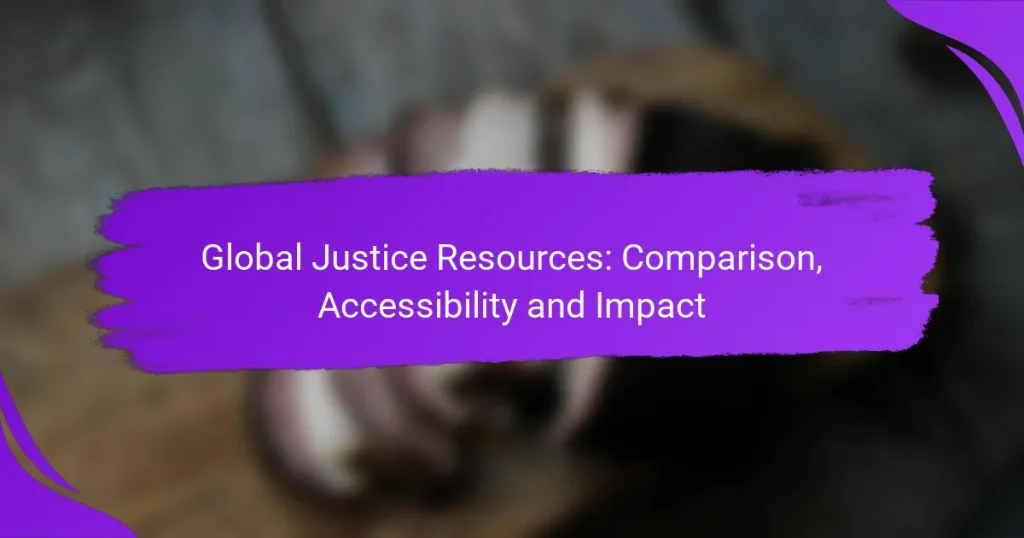Global justice resources play a crucial role in addressing human rights violations and fostering accountability worldwide. These resources differ in accessibility, impact, and funding, making it vital for stakeholders to understand their unique characteristics to utilize them effectively.

What Are the Key Global Justice Resources?
Key global justice resources provide essential tools and frameworks for addressing human rights violations and promoting accountability. These organizations work to uphold justice, advocate for victims, and influence policy on a global scale.
International Criminal Court
The International Criminal Court (ICC) prosecutes individuals for serious crimes such as genocide, war crimes, and crimes against humanity. Established in 2002, it operates under the Rome Statute and aims to ensure that perpetrators of the most serious offenses are held accountable.
Countries that ratify the Rome Statute are obligated to cooperate with the ICC. However, some nations, including the United States and Russia, have not joined, which can limit the court’s reach and effectiveness in certain regions.
Human Rights Watch
Human Rights Watch (HRW) is a non-profit organization that conducts research and advocacy on human rights issues worldwide. It publishes detailed reports on abuses and works to influence governments and institutions to uphold human rights standards.
HRW’s reports often highlight urgent issues, such as the treatment of refugees or the rights of marginalized communities. Engaging with their findings can provide valuable insights for activists and policymakers seeking to drive change.
Amnesty International
Amnesty International is a global movement focused on protecting human rights through research, advocacy, and mobilization. Founded in 1961, it campaigns against injustices and supports individuals whose rights are violated.
Amnesty’s work includes letter-writing campaigns, public awareness initiatives, and lobbying efforts. Their annual reports provide a comprehensive overview of the state of human rights in various countries, serving as a resource for activists and researchers alike.
Global Fund for Human Rights
The Global Fund for Human Rights provides financial support to grassroots organizations working to protect human rights and promote justice. It focuses on empowering local activists and ensuring that their voices are heard in the global arena.
By funding initiatives that address specific human rights challenges, the fund helps create sustainable change. Organizations seeking support must demonstrate a clear impact and a commitment to human rights advocacy.
United Nations Development Programme
The United Nations Development Programme (UNDP) works to eradicate poverty and reduce inequalities while promoting sustainable development. It emphasizes the importance of human rights as a foundation for development efforts.
UNDP collaborates with governments and local organizations to implement programs that enhance governance, rule of law, and human rights protections. Their initiatives often include capacity-building efforts and policy reforms that align with international human rights standards.
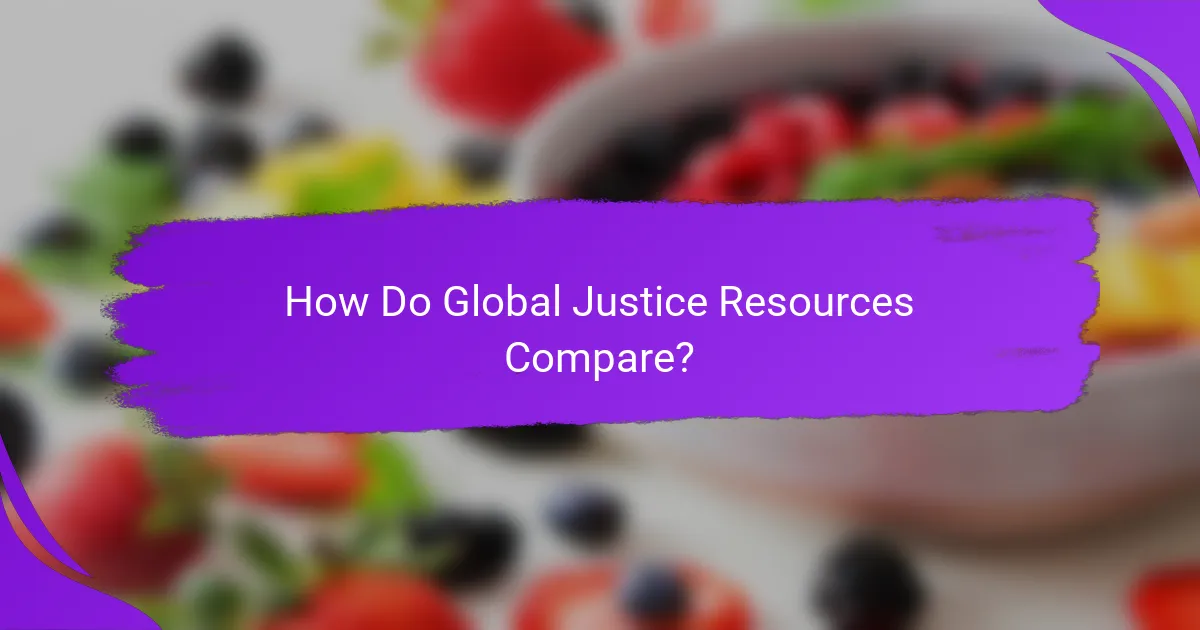
How Do Global Justice Resources Compare?
Global justice resources vary significantly in their accessibility, impact, funding, and geographic focus. Understanding these differences is essential for stakeholders aiming to leverage these resources effectively.
Resource Accessibility
Accessibility of global justice resources refers to how easily individuals and organizations can obtain and utilize them. Factors influencing accessibility include language availability, digital infrastructure, and legal frameworks. For instance, resources that are available in multiple languages and have user-friendly online platforms tend to be more accessible to a broader audience.
Organizations should consider the technological barriers that may prevent access, especially in low-income regions. Providing offline resources or mobile-friendly versions can enhance accessibility for users with limited internet access.
Impact Assessment
Impact assessment evaluates the effectiveness of global justice resources in achieving their intended outcomes. This can involve qualitative measures, such as user feedback, and quantitative metrics, such as the number of cases resolved or communities served. Regular assessments help organizations refine their strategies and improve resource delivery.
It is crucial to establish clear benchmarks for success before implementing resources. For example, a justice program might aim for a specific percentage increase in legal literacy within a community over a defined period.
Funding Sources
Funding sources for global justice resources can vary widely, including government grants, private donations, and international aid. Understanding the funding landscape is vital for sustainability and growth. Organizations often rely on a mix of these sources to ensure financial stability.
Nonprofits should explore diverse funding opportunities, such as crowdfunding or partnerships with corporate sponsors, to enhance their financial resilience. Transparency in how funds are allocated can also build trust with stakeholders and beneficiaries.
Geographic Focus
The geographic focus of global justice resources determines where and to whom these resources are directed. Some initiatives may target specific regions, such as Eastern Europe or Sub-Saharan Africa, while others may have a more global approach. Tailoring resources to local contexts can significantly enhance their effectiveness.
Organizations should conduct thorough research on the legal and cultural landscapes of their target areas. This ensures that the resources provided are relevant and sensitive to local needs, ultimately leading to better outcomes in justice delivery.
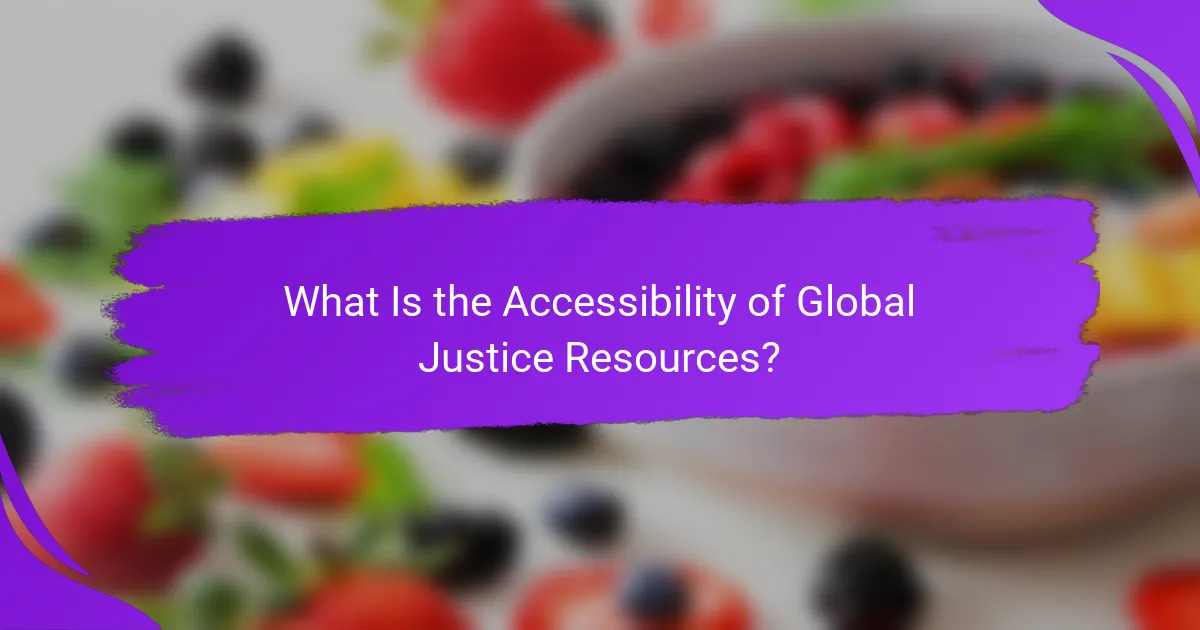
What Is the Accessibility of Global Justice Resources?
The accessibility of global justice resources varies significantly based on location, type of service, and community engagement. These resources can be found through various channels, including online platforms, community outreach programs, and legal aid services, each offering unique advantages and challenges.
Online Platforms
Online platforms provide a convenient way to access global justice resources, allowing users to find information and services from anywhere with internet connectivity. Websites and applications often feature databases of legal documents, educational materials, and forums for discussion.
However, the effectiveness of these platforms can depend on internet access and digital literacy. Users in rural or underserved areas may struggle to utilize these resources fully. It’s essential to ensure that platforms are user-friendly and available in multiple languages to reach a broader audience.
Community Outreach Programs
Community outreach programs aim to bring global justice resources directly to local populations, often through workshops, seminars, and informational sessions. These programs can effectively raise awareness and educate individuals about their rights and available resources.
To maximize impact, outreach initiatives should be tailored to the specific needs of the community they serve. Collaborating with local organizations can enhance trust and participation. Consideration of cultural sensitivities and language barriers is crucial for successful engagement.
Legal Aid Services
Legal aid services offer essential support to individuals who cannot afford legal representation, ensuring access to justice for marginalized communities. These services often include free or low-cost legal advice, representation, and assistance with navigating the legal system.
Availability can vary widely by region, with some areas having robust legal aid networks while others may have limited resources. It’s important for individuals seeking assistance to research local legal aid organizations and understand the eligibility criteria, which may include income thresholds and specific legal issues.
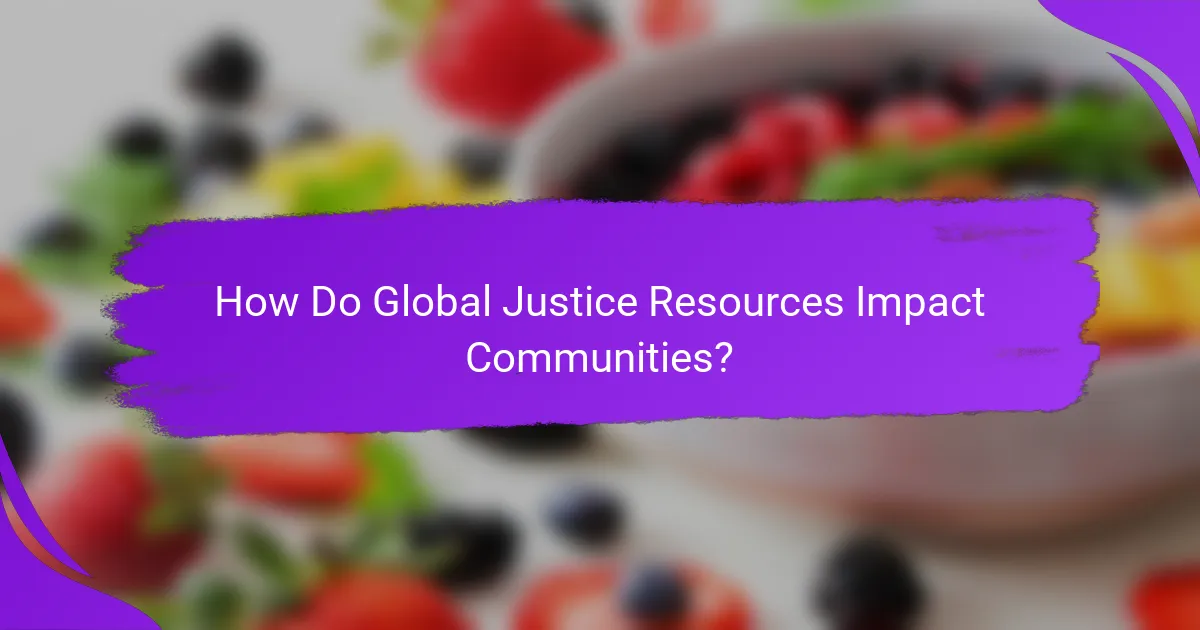
How Do Global Justice Resources Impact Communities?
Global justice resources significantly influence communities by promoting equity, enhancing legal access, and fostering social change. These resources empower individuals and organizations to address injustices and advocate for their rights, ultimately leading to improved societal conditions.
Case Studies
Case studies illustrate the tangible effects of global justice resources on communities. For example, a legal aid organization in Eastern Europe provided pro bono services to marginalized groups, resulting in increased access to justice and successful legal outcomes. Another case in South America demonstrated how community-led initiatives, supported by international NGOs, effectively challenged discriminatory practices.
Success Stories
Success stories highlight the positive transformations brought about by global justice resources. In Africa, a grassroots movement utilized funding from global justice initiatives to secure land rights for local farmers, significantly improving their livelihoods. Similarly, a campaign in Southeast Asia raised awareness about human trafficking, leading to stronger laws and better protection for vulnerable populations.
Challenges Faced
Despite their impact, global justice resources encounter several challenges. Limited funding and resources can hinder the scalability of successful programs, making it difficult to reach broader populations. Additionally, cultural and political resistance may obstruct the implementation of justice initiatives, requiring advocates to navigate complex local dynamics.
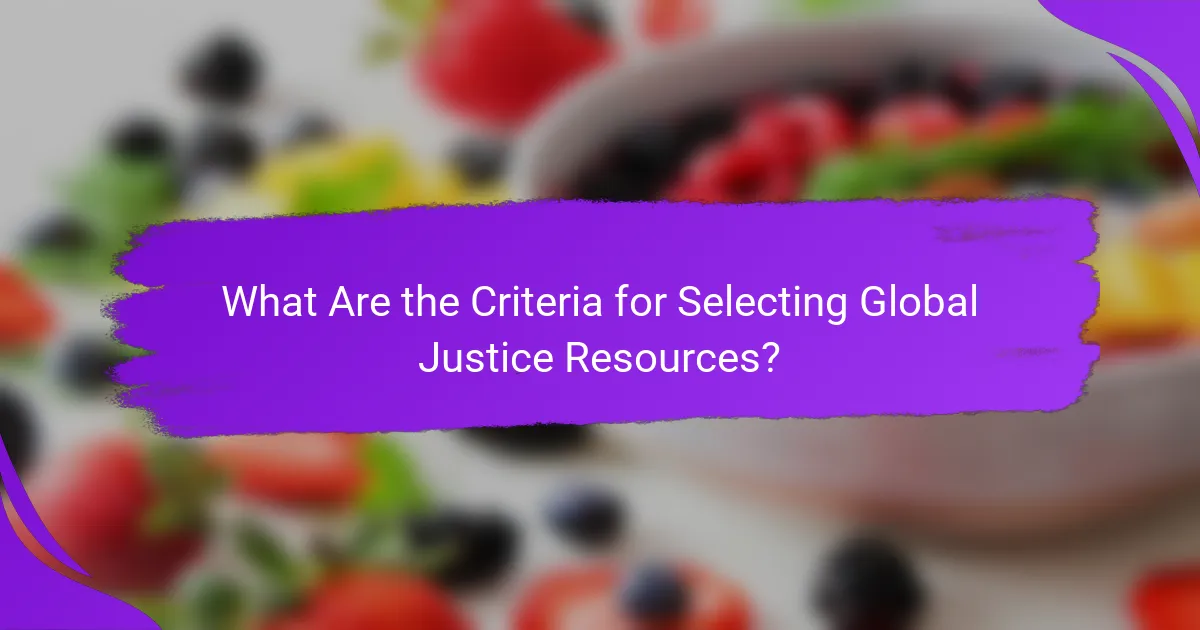
What Are the Criteria for Selecting Global Justice Resources?
When selecting global justice resources, key criteria include their reputation, credibility, and effectiveness metrics. These factors help ensure that the resources are reliable and impactful in promoting justice on a global scale.
Reputation and Credibility
Reputation and credibility are essential when evaluating global justice resources. Look for organizations with a strong track record, endorsements from reputable institutions, and transparency in their operations. Resources backed by well-known NGOs or academic institutions often carry more weight.
Consider checking reviews, testimonials, and case studies that demonstrate the resource’s impact. Engaging with communities that have utilized these resources can also provide insight into their effectiveness and reliability.
Effectiveness Metrics
Effectiveness metrics help assess how well global justice resources achieve their intended outcomes. Common metrics include the number of beneficiaries served, improvements in legal access, and measurable changes in community well-being. Resources that provide clear data on their impact are generally more trustworthy.
When evaluating effectiveness, look for resources that utilize standardized evaluation frameworks, such as the Logical Framework Approach or Theory of Change. These frameworks can help clarify the resource’s goals and the means by which they measure success.
